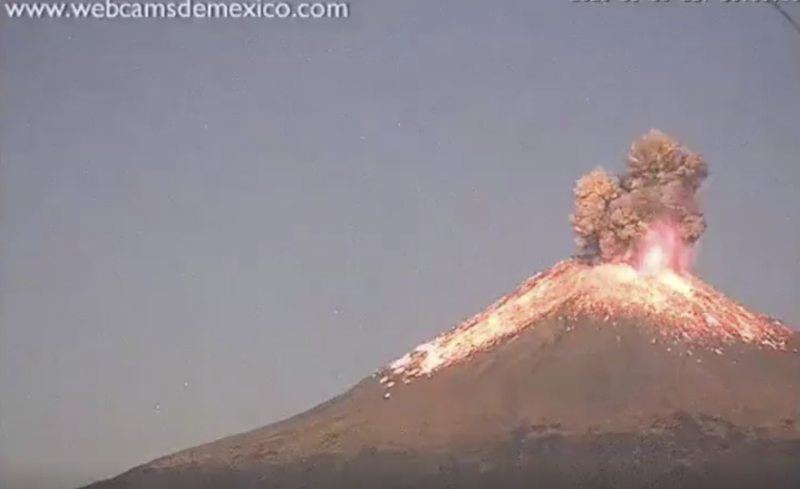
The active volcano Popocatépetl – just 43 miles (70 km) southeast of Mexico City, and visible from there when atmospheric conditions permit – erupted Thursday morning, January 9, 2020, spewing ash high into the air and oozing lava. Popocatépetl is affectionately called El Popo by Mexicans. It’s one of Mexico’s most active volcanoes. Officials have issued a yellow alert in response to the blast, which took place at around 6:30 a.m. local time.
The translation for the AmarilloFase2 (Yellow Alert) explained in the tweet below is as follows:
Preventive actions for the alert level #AmarilloFase2 : Stay tuned for official information. Prepare important documents. Perform drills and know the location of temporary shelters. Develop a family plan for Civil Protection.
Acciones preventivas para el nivel de alerta ? #AmarilloFase2:
? Mantenerse atento a la información oficial.
? Preparar documentos importantes.
? Realizar simulacros y conocer la ubicación de refugios temporales.
? Elaborar un plan familiar de Protección Civil. pic.twitter.com/KUkiHOrnhX— PC Estatal Puebla (@PC_Estatal) January 9, 2020

Spectacular eruption from one of Mexico’s most active volcanoes, Popocatepetl, Thursday morning. Image via @webcamsdemexico on Twitter.
Officials said the eruption sent up a column of smoke about 2 miles (3 km) into the air, with a moderate ash content.
NOAA’s GOES 16 satellite caught the eruption from space.
SATELLITE SPOTLIGHT: @NOAA's #GOES16 watched as #Mexico's #Popocatépetl #volcano erupted early this morning. The #satellite's #GeoColor band saw the #ash cloud (red circle) but its SO2 composite detected the #SulfurDioxide in the #AshPlume, which shot about 20,000 feet high. pic.twitter.com/9V2bueFOeY
— NOAA Satellites – Public Affairs (@NOAASatellitePA) January 9, 2020
Popocatépetl has low- or medium-level eruptions often, and at times erupts more or less continuously. It has had more than 15 major eruptions since the arrival of the Spanish in 1519, according to Wikipedia.
This morning’s eruption was a beauty, though! In part because of its location so near Mexico City, many cameras are trained on the volcano, and thus the January 9, 2020 eruption has been well documented so far, at this writing mostly on Twitter and YouTube.
Click here for live webcams – trained on Popocatépetl from VolcanoDiscovery.com
Está mañana el volcán Popocatépetl registró un explosión con contenido moderado de ceniza.
El reporte de la Coordinación Nacional de Protección Civil fue a las 6:33 de la mañana cuando se reportó actividad moderada, expulsando una columna de humo de 3 kilómetros. pic.twitter.com/4DuzS2qP1J— Arturo en la Radio (@Enlaradiofm) January 9, 2020
#Popocatepetl pic.twitter.com/w4DsOvlZIp
— geentolentino (@geentolentino) January 9, 2020

A gorgeous shot of Popocatépetl on January 9, 2020, as the sun rose on its eruption. Image via @nuriapiera on Twitter.
Bottom line: Photos and videos of Popocatépetl volcano, near Mexico City, which erupted on January 9, 2020.
from EarthSky https://ift.tt/2uyDJSZ

The active volcano Popocatépetl – just 43 miles (70 km) southeast of Mexico City, and visible from there when atmospheric conditions permit – erupted Thursday morning, January 9, 2020, spewing ash high into the air and oozing lava. Popocatépetl is affectionately called El Popo by Mexicans. It’s one of Mexico’s most active volcanoes. Officials have issued a yellow alert in response to the blast, which took place at around 6:30 a.m. local time.
The translation for the AmarilloFase2 (Yellow Alert) explained in the tweet below is as follows:
Preventive actions for the alert level #AmarilloFase2 : Stay tuned for official information. Prepare important documents. Perform drills and know the location of temporary shelters. Develop a family plan for Civil Protection.
Acciones preventivas para el nivel de alerta ? #AmarilloFase2:
? Mantenerse atento a la información oficial.
? Preparar documentos importantes.
? Realizar simulacros y conocer la ubicación de refugios temporales.
? Elaborar un plan familiar de Protección Civil. pic.twitter.com/KUkiHOrnhX— PC Estatal Puebla (@PC_Estatal) January 9, 2020

Spectacular eruption from one of Mexico’s most active volcanoes, Popocatepetl, Thursday morning. Image via @webcamsdemexico on Twitter.
Officials said the eruption sent up a column of smoke about 2 miles (3 km) into the air, with a moderate ash content.
NOAA’s GOES 16 satellite caught the eruption from space.
SATELLITE SPOTLIGHT: @NOAA's #GOES16 watched as #Mexico's #Popocatépetl #volcano erupted early this morning. The #satellite's #GeoColor band saw the #ash cloud (red circle) but its SO2 composite detected the #SulfurDioxide in the #AshPlume, which shot about 20,000 feet high. pic.twitter.com/9V2bueFOeY
— NOAA Satellites – Public Affairs (@NOAASatellitePA) January 9, 2020
Popocatépetl has low- or medium-level eruptions often, and at times erupts more or less continuously. It has had more than 15 major eruptions since the arrival of the Spanish in 1519, according to Wikipedia.
This morning’s eruption was a beauty, though! In part because of its location so near Mexico City, many cameras are trained on the volcano, and thus the January 9, 2020 eruption has been well documented so far, at this writing mostly on Twitter and YouTube.
Click here for live webcams – trained on Popocatépetl from VolcanoDiscovery.com
Está mañana el volcán Popocatépetl registró un explosión con contenido moderado de ceniza.
El reporte de la Coordinación Nacional de Protección Civil fue a las 6:33 de la mañana cuando se reportó actividad moderada, expulsando una columna de humo de 3 kilómetros. pic.twitter.com/4DuzS2qP1J— Arturo en la Radio (@Enlaradiofm) January 9, 2020
#Popocatepetl pic.twitter.com/w4DsOvlZIp
— geentolentino (@geentolentino) January 9, 2020

A gorgeous shot of Popocatépetl on January 9, 2020, as the sun rose on its eruption. Image via @nuriapiera on Twitter.
Bottom line: Photos and videos of Popocatépetl volcano, near Mexico City, which erupted on January 9, 2020.
from EarthSky https://ift.tt/2uyDJSZ

Aucun commentaire:
Enregistrer un commentaire